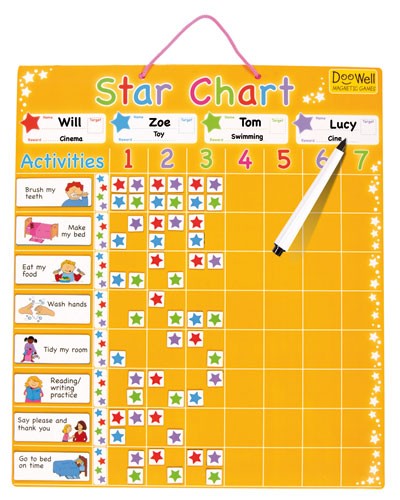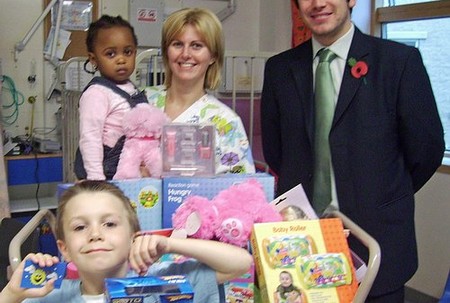As children get older they can appreciate rewards that are more abstract and less immediate. Now they can visualize the payout from stars, points or tokens.
Star charts
Stars allow us to focus a child’s attention on specific behaviors that need to be changed.
Stars only work with children who are old enough to recognize what they represent. They have no meaning for the under-four-year-old.
You also need to remember that stars create maximum interest in the first week, less in the second and soon the star burns out, leaving a black hole.

Stars: the behaviors to target
The targets we star must be clear-cut and easily achievable. It’s pointless expecting a child to ‘be good all day’, or to ‘not annoy your sister’. A turnaround of this magnitude is reserved for faith healers, miracle workers and saints.
I use stars to highlight two or more simple behaviors; for example, brushes teeth, makes bed, does dishes, ready for school on time.
Stars can also be used when there are problems of bladder training. A dreamy five-year-old leaves things too late, which results in little leaks? Using the chart we focus all attention on short periods of dryness. If dry from the moment they wake until breakfast time, they get a star. From breakfast to mid morning break, a star. From break to lunch, to mid afternoon, to dinner, to bedtime, the stars continue.
Some use stars to motivate bed wetters, but this has little success. When children are asleep they are not thinking of stars.
We can also use the star system to treat children who still soil their pants. First you must ensure your child is not constipated, and then use stars in a step-by-step way.
The first goal is to get them to sit for five minutes after breakfast, after school and after dinner. Each sit is recognized with a star. Once sitting is established the focus now moves to using the toilet. If on any occasion a poo pops out we give great praise and the appropriate square is colored in. Finally, the focus moves to being clean from dawn to dusk with four gold stars for a soil-free day.
The token system
This is a popular technique that takes an impossibly big task and divides it into small manageable units. It is based on the same principle as my Frequent Flyer points. My favorite airline wishes to encourage a certain behavior (loyalty to Qantas) so I receive 700 points each time I fly from Sydney to Brisbane. These points have no value but I know that if I keep producing the desired behavior (flying Qantas) the individual points will eventually be rewarded with a free flight. After a year of this correct behavior I get a special treat, like a holiday in Alice Springs.
Tokens in the classroom
A child with Attention Deficit Hyperactivity Disorder (ADHD) has great difficulty sustaining attention in the busy classroom. They can be motivated by a promise of time on the computer, for example, but even with this carrot they can’t concentrate long enough to earn the reward. Our goal is to increase that child’s time on task by focusing on small, achievable periods of good concentration.
The teacher breaks the day into ten-minute periods, and each period on task is acknowledged with a token. These are simply a bead, button or piece of chalk that is placed in a glass. When ten tokens have been earned, this is rewarded by time on the computer.
Tokens and car travel
Many parents dread the drama of long-distance car travel: ‘He hit me.’
‘She’s looking out of my window.’ ‘He’s taking all the space.’ ‘Are we there yet?’
You buy books and games and even place a large barricade of well-secured luggage between the combatants but the pain continues. Now try a token system. For every fifteen minutes of peace a token is dropped in a cup and this adds up to a payout of money or a special treat at the next fuel stop. Tokens won’t turn a terrorist into an angel, but they are more appropriate than deep sedation or a straitjacket.
Points and money
Good behavior can be encouraged by a simple system of points or money. Feeding the dog gets one point or ten pence. Bedtime without complaint, two points or twenty pence. A tidy room at 6 pm gets three points or thirty pence.
When the points reach a certain number, this represents a special treat. When the money gets to a certain total it can be used to buy some much-wanted piece of junk.

Purists dislike the thought of buying good behavior, but if it works and gets you off your Valium, I won’t object.
Every child has their price
Parents often tell me that none of my suggestions will motivate their child. But I believe every human has their price. I expect if you placed a big enough sheaf of crisp new bank notes in the hand of a twelve-year-old, they might listen. I expect if a tip-truck were to dump 1000 Mars Bars in your front drive, most five-year-olds might show some interest.
It’s up to us to work out what we can afford and sustain. Fortunately, for most children the major motivator is the subtle system of attention, noticing, time, interest and specific appreciation.